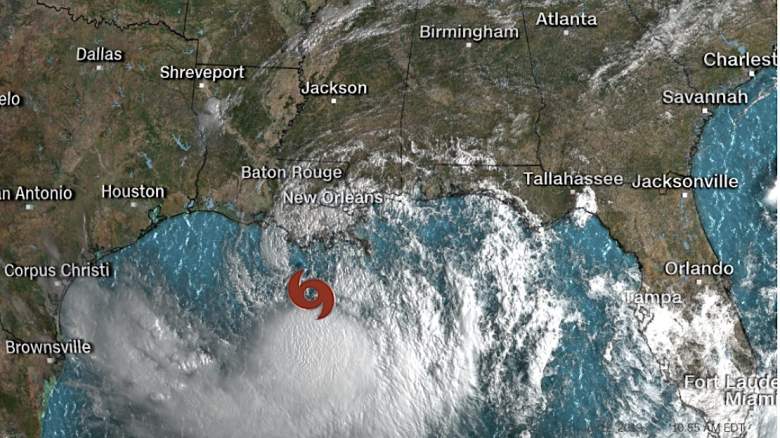
The National Weather Service has been closely watching Tropical Storm Barry since it first started to threaten the coast of Louisiana with torrential downpours on Tuesday. On Wednesday, Louisiana was declared to be in state of emergency, and by Thursday, mandatory evacuations started taking place.
As predicated, the tropical storm strengthened as it slowly spun across the Gulf of Mexico, and was officially categorized as Hurricane Barry on Saturday, making it the first major storm of 2019. Hurricane Barry is currently sustaining winds of 75 mph as it approaches landfall.
Louisiana Governor John Bel Edward put out an official statement saying, “This is going to be a Louisiana event with coastal flooding and widespread, heavy rainfall potentially impacting every part of the state. No one should take this storm lightly. As we know all too well in Louisiana, low intensity does not necessarily mean low impact.”
The National Hurricane Center noted that the storm is “moving slowly westward across the Northern Gulf of Mexico,” and after making landfall on Saturday, along with storm-surge, hurricane force winds, 15 to 25 of inches of rain is predicated across various areas of the state.
Here’s what you need to know about Hurricane Barry….
1. Louisiana and Surrounding States Must Prepare For Impact
While the southern coast of Louisiana appears to be Hurricane Barry’s main target, surrounding states must also prepare for heavy rainfall and flooding. Other areas that could feel the grunt of the storm includes coastal Mississippi, southeastern Arkansas parts of Alabama, and the Florida Panhandle.
While mandatory evacuations were made in Plaquemines Parish, Louisiana’s southeastern tip, they were also made in parts of Lafourche Jefferson Parish, including the town of Grand Isle. In New Orleans, neither mandatory nor voluntary evacuations have been ordered. Latoya Cantrell, the city’s mayor, said they only enact evacuations for hurricanes of Category 3 force or higher.
2. Residents Are Encouraged to Prepare Emergency Hurricane Kits Ahead of Time
The National Weather Service encourages anyone in the storm’s path to prepare a hurricane kit sooner rather than later. According to Ready.gov, such kits should include a hand crank radio or batter-powered radio in order to receive important news updates, one gallon of water per son per day for at least three days, a three-day supply of non-perishable food, a flashlight, first aid kid, extra batteries, whistle to signal for help, dust masks to help filter through contaminated air, plastic sheeting and duct to secure down shelter, cleansing toilettes for personal sanitation, manual can opener, wrench or pliers to turn off utilities, local maps, and back-up chargers for your cell phone.
It’s also suggested to pre-store important paper documents in waterproof containers, or to back them up electronically, and to clear any clogged rain gutters and rain spouts ahead of time in order to help with the flow of heavy rain during a hurricane.
For a list of additional emergency supplies, including instructions for people who require certain daily medications, have pets, or young children, click here.
3. Hurricane Barry Will Be the First Real Test for Levees Built After Hurricane Katrina
The Mississippi River is already swollen from the rainfall earlier in the week, when nearly 8 inches of rain was dumped in New Orleans in the span of just three hours.Traffic was at a standstill and people were seen kayaking in the streets which had turned into rivers. Further rainfall puts the city and surrounding areas at risk for more extreme flash floods, which could possibly send water over the levees.
Ricky Boyett, a spokesman for the Army Corps of Engineers in New Orleans said the agency is not expecting water to overtop of the levees everywhere, which were built to protect water levels rising anywhere from 20 to 25 feet after the devastation of Katrina in 2005, but that there are concerns for areas south of the city. “We’re confident the levees themselves are in good shape,” he said. “The big focus is height.”
Governor Edwards preemptively ordered the distribution of sandbags, and surrounded the state with National Guard troops and high water vehicles.
4. Several Airlines Are Already Offering Travel Vouchers
Delta, United, Southwest, Spirit, Jet Blue, and American Airlines, are already offering those with plans to travel to the effected areas near the Gulf of Mexico during Hurricane Barry waiver to change their flights at no cost.
To see which airlines are offering waivers and on what days, visit their individual sites to check out your rebooking options.
5. The Main Threat of Hurricane Barry is the Amount of Rainfall
According to AccuWeather, Hurricane Barry can bring 2-4 inches of rainfall per hour once it begins to move onshore, with an AccuWeather Local StormMax of 24 inches possible in some places. Hurricane Expert Dan Kottlowski confirmed, “Our greatest concern is for torrential rain that would result in life-threatening flooding.”
Because Hurricane Barry is a Category 1 storm, the threat of tornadoes and damaging winds are not expected.
READ NEXT: Is Facebook’s ‘Area 51: They Can’t Stop Us All’ Event Real or Fake?

